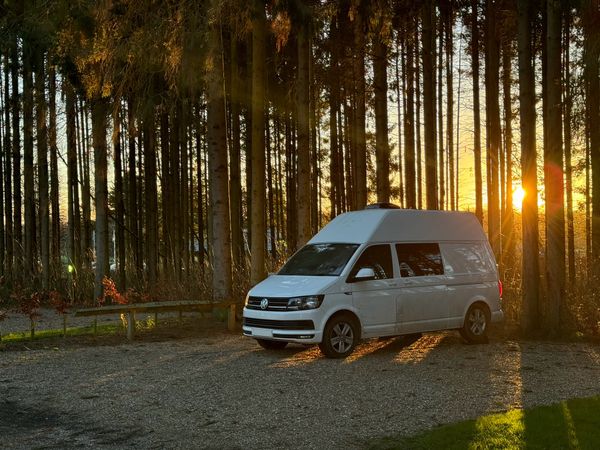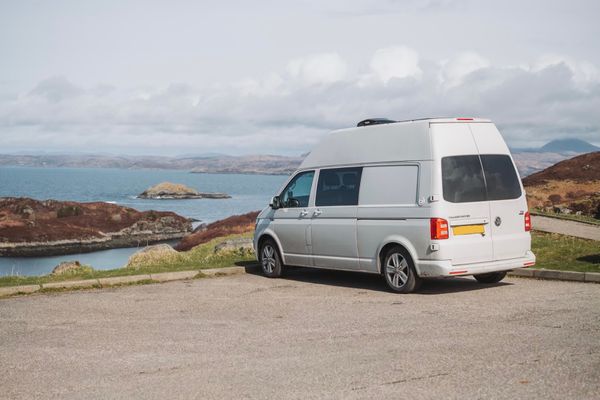It’s every van-lifer’s nightmare: You’re on the scenic road trip of a lifetime, the views are out of this world and every day brings a new adventure. But you wake up one morning and your campervan doesn’t start – maybe you accidentally left the lights on when you pitched up – and you’re stranded. What do you do? Call a breakdown service and wait for who knows how many hours until they come and rescue you, potentially losing a day of sightseeing and messing up your itinerary? Or do you stand in the rain trying to flag someone down that has a jumper cable to help you get going again? When we were prepping for our 4 week road trip on the NC500 in Scotland, neither of these options sounded particularly appealing, and with colder temperatures and a lot of driving ahead, we invested in a MUST-HAVE piece of kit to give us peace of mind on our big adventure. Read on to find out why you need to add the NOCO GBX75 portable jump starter to your van kit!
Table of Contents
What is the NOCO GBX75?
The NOCO GBX75 is a portable lithium-ion jump starter that can boost a flat battery in an instant and help you get enough charge in your vehicle battery to get you back on the road. There is no need for a donor vehicle, and even the least mechanically savvy people can use it with ease – our first use took us just minutes!
The small and ultra-portable design means that you can store the NOCO GBX75 in the boot of your vehicle, under a seat, or at the bottom of a cupboard without taking up too much valuable space. Simply charge it up before you leave the house, and forget about it until you need it (which hopefully you won’t!). In the event that you do need to jump start your van, it’ll be ready to get you going again and has everything you’ll need, contained in one small package.
The NOCO GBX75 can jump start vehicles of all sizes up to 8.5L for petrol and 6L for diesel with a 12v battery – this is plenty big enough to start most motorhomes and campervans. When our battery died on the driveway of one of our pet sits in the summer, the GBX75 effortless started our VW Transporter T6 on the first attempt.
While there are other portable jump starters on the market, what sets the NOCO GBX75 apart is the safety and foolproof features. The GBX75 has a 60 second cut-off timer which prevents the vehicle draining the device if left attached, helping to conserve the battery life (if another boost is required, you can turn it off and back on again). Another important safety feature is the spark-proof technology and reverse polarity protection – meaning if you put the clamps on the wrong way round, it won’t spark and damage the battery. The NOCO UltraSafe technology really gives novices (like us!) huge peace of mind. There are also plenty of LEDs on the device to let you know exactly when it’s ready to go, or if there are any errors.

Our experience
At the beginning of the year we spent a few weeks staying with family, so we weren’t driving our van too much, and in that time the battery in our VW Transporter managed to drain to the point where the van wouldn’t start. At the time we didn’t have the NOCO GBX75, so we had to call out roadside assistance to get us going. As is the case these days, there was no complicated equipment involved and roadside assistance got us up and running in just minutes. Chatting to them afterwards about the equipment, we found out it was a NOCO GBX75 they use to get vans back on the road. In an effort to cut out the middle man, and ensure that we’d always be able to jump start our van ourselves wherever we roam, we ordered our own that same day!
Six months later, after a relaxing few weeks at a rural pet sit, we had just packed up our campervan ready to leave for our next adventure, but again our engine wouldn’t start. After a quick read of the NOCO manual, we attached the GBX75 to our battery, waited for the light to show that it was connected, and started the engine. The van started first time and we were on our way – it really is that easy!
How to use the NOCO GBX75
Using the NOCO GBX75 is super simple. Before starting, it’s a good idea to turn off anything in the vehicle that uses power, such as the radio, lights and AC. Then open the bonnet, or wherever the vehicle battery is stored, and locate your battery – making sure the battery terminals aren’t covered by any caps. Now you are ready to jump start the battery as follows:
Connect the clamp on the negative cable (black) to the negative terminal on the battery (or to a grounded point on the vehicle chassis)
Connect the clamp on the positive cable (red) to the positive terminal on the battery
Press the power button on the GBX75 and the battery level LEDs will start to chase. When it’s ready to go, the white boost LED will turn on
You now have 60 seconds to start your van’s engine
Once the vehicle has started, power off the unit and remove the clamps from the battery
You should leave the vehicle running and, if you can, give it a good drive of at least 30 minutes to charge. When possible, use a battery charger to give the battery a proper charge.
It should go without saying that you need to make sure you’ve read the supplied manual, and understand how to jump start your vehicle, before attempting to carry out the jump start.
Charging the NOCO GBX75
The NOCO GBX75 has an impressive battery – jump starting our VW Transporter T6 didn’t decrease the battery indicator at all – so in theory you should be able to carry out multiple starts from a single charge. However, it’s good practice to charge the jump starter whenever it’s used so that the next time you need it, it’s fully charged.
On one end of the NOCO GBX75 there are two USB sockets: One is a USB-A Out for charging devices (see below) and the other is a USB-C In and Out. The USB-C In and Out is the socket used for charging the GBX75. The GBX75 comes supplied with a USB-C charging cable and a USB-C to 12v charging cable.
The amount of time it takes for the device to reach full power depends on the type of charger you use. If you use the included 12v charging cable and plug it into your vehicle’s 12v cigarette socket, you should be able to charge the NOCO GBX75 whilst driving in just 1.7 hours. You can also use a compatible 60W USB-C plug at home to fast charge in 1.7 hours. If you’re using a fast charger, a 5 minute charge should be long enough for one jump start. If you only have a standard 5W plug (e.g a phone charger) the charging time increases to 20 hours.
The GBX75 can keep hold of its charge for up to a year, so if you don’t need to use it within 12 months, you can just leave it in your van and it will retain its charge – just another of the many impressive qualities of the GBX75! It is truly built to be a reliable and fuss-free device.
Other uses
There are a few extra features on the GBX75 that are designed to provide you with a little helping hand in the event that you do need to use it. Firstly, there’s a 400 Lumen light on the front with various brightness settings, and it’s bright enough to illuminate under the bonnet should you break down at night. There’s also a strobe setting if you need to alert passersby of your presence.
Another useful feature is that the GBX75 can double as a USB power bank, so you can charge devices such as your phone in an emergency. In order to preserve the battery life for jump starting, we recommend that you only use this feature in an emergency. But it’s reassuring to know that you have the ability to charge your devices if needed.
There is also an override feature for jump starting. We do not recommend using this unless you know exactly what you’re doing! The manual override button will turn off all the safety features such as reverse-polarity protection and anti-spark. But this may be useful if you are trying to jump start a battery with a very low voltage.



What’s in the box?
GBX75 Lithium Jump Starter – jumper cables with clamps are attached
USB-A to USB-C Cable – for charging at home
12V to USB-C Cable – to charge via vehicle cigarette socket
Microfibre Storage Bag
User Guide
Negatives
There aren’t many negatives to the NOCO GBX75! The price point is high for a device that you hope you’ll never have to use, but we are firm believers of investing once in something that is built to last rather than buying a cheaper alternative and having to replace it, or worse, having it fail on you in an emergency. Another minor negative is that the jump leads are short – just long enough to attach to the battery – where a little more length would allow you to place the device further out of the way. The positive of the shorter leads, however, is that this helps keep the jump starter compact in size for easy storage.
Where to buy
The NOCO GBX75 is available to buy through Amazon. Use the link to take a look and if you do decide to purchase the GBX75, we will receive a small commission (Thank-you!)
We’d also recommend purchasing a hard storage case to protect the device. We store our GBX75 in our van at all times, and with the hard case we don’t need to worry about the GBX75 getting damaged while we drive. There is a GBC103 case specifically made for storing the GBX75, however we have the GBC014 case as it fits the same, and is half the price!!
In addition to our jump starter, we also have the NOCO Genius 5 – a battery charger and maintainer – to keep our device in tip-top condition and ensure it lasts us for many years of road tripping to come.
Conclusion
In our opinion, despite the high upfront cost, there’s no price you can put on being able to relax on long road trips in your van. A portable jump starter is a great investment, and buying one from a reputable brand with years of experience in the automotive industry, is a wise one. Plus the extra safety features of the NOCO GBX75 will give you peace of mind knowing that should your battery die, you’ll be able to get back on the road again quickly and without calling roadside assistance. Paired with a NOCO Genius 5, you’ll have the ultimate set-up for uninterrupted adventuring!
If you found this post helpful, please consider supporting our blog by donating as little as £1 to our running costs! Thank-you!

We are Chris+Suze







